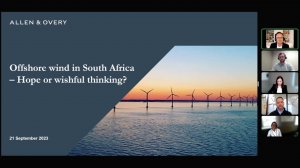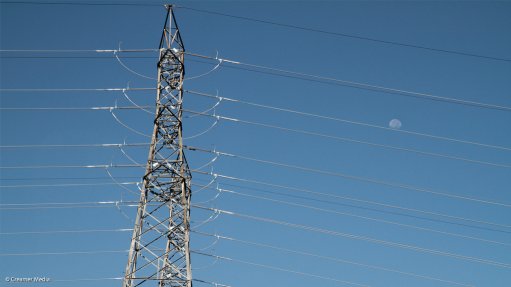Experts explore offshore wind’s potential in SA energy mix

Industry experts unpack the potential of offshore wind in South Africa, as well as regulatory obstacles
With the World Bank estimating South Africa to have 901 GW of offshore wind generation potential, legal and consulting professionals are examining the promising opportunities and challenges associated with the emerging sector.
Academic research has pinpointed several areas, including Cape Town, Hermanus, Mossel Bay, Richards Bay, Durban and Struisbaai as highly promising locations for harnessing the power of offshore winds.
While offshore wind farms are more expensive to build than onshore wind projects – costing between 2.5 to three times more – it has the potential for consistent and greater volumes of electricity generation, law firm Allen & Overy stated, in hosting a webinar on Thursday on the matter.
Consultancy Zutari senior renewable energy engineer James Larmuth said the average wind speed on the South African coast was seven metres a second, but that there were locations that recorded above ten metres a second.
Larmuth said that offshore wind could add another diversification to South Africa’s energy mix and form part of the country’s sustainable future. Offshore is currently not included in the Integrated Resources Plan (IRP) 2019, but may feature in the awaited IRP 2023.
During the webinar, experts emphasised the crucial role of government support in making offshore wind projects a reality. Government oversees the issuance of coastal use permits and manages marine spatial planning.
Allen & Overy project development partner Alessandra Pardini shed light on the intricacies of onshore wind projects. In contrast to onshore wind endeavours that primarily require land leases, offshore wind projects entail a more complex legal framework. This complexity stems from various factors, including decisions related to fixed or floating infrastructure, as well as more complicated environmental considerations.
While acknowledging the complexity of this legal and regulatory environment, Pardini said it was entirely navigable, drawing parallels with sectors such as oil and gas and telecommunications, which had successfully obtained the acquired permits and licences for ocean activity.
Pardini suggested that in the case of offshore wind generation not being driven by State-owned power utility Eskom or government, another option is bilaterial agreements involving the private sector, with an offtaker signing a direct agreement for power. A good example of such a customer would be a hydrogen company needing to supply electrolysers with renewable energy.
Allen & Overy attorney Gillian Niven echoed Pardini’s sentiments, stating that while some regulatory challenges in offshore wind projects were familiar to project developers in South Africa and the renewable energy sector, the marine environment context presented a new dimension.
She elaborated on the unique nature of the challenge, noting that regulators have not previously considered offshore activity from a renewable energy development perspective. Consequently, the specific requirements remain uncertain.
Niven explained that regulators were cautious when it came to permitting new alternative technologies, as they aimed to avoid any potential backlash or risks associated with unchartered territory.
“We have seen a heightened sensitivity around the marine environment in particular, not that any project in the ocean is a no-go, but stakeholder engagement and thorough environmental impact assessments (EIAs) become critical to the permitting process.”
Niven confirmed that government was running a marine spatial planning exercise through the Department of Planning, Monitoring and Evaluation, in its endeavour to unlock the ocean economy and maintain a healthy marine ecosystem. The Marine Spatial Planning Act requires that any licence or permit be consistent with the Marine Area Plans that have been approved.
There is another piece of legislation called the Integrated Coastal Management Act, which empowers the Minister of Forestry, Fisheries and the Environment to prohibit activities within coastal water property and list activities for the grant of a coastal use permit.
“That instrument can be awarded to an applicant in the private sector, but it also allows the Minister to issue coastal use permits under a prescribed process, such as an auction. Those permits are typically valid for years,” Niven noted, adding that the framework for offshore project approvals does exist, but it is unclear whether this marine spatial planning will be aligned with the IRP.
Niven said there would certainly need to be a balance of rights between the different uses of the coast.
Consultancy SLR technical director Stuart Heather-Clark introduced another potential obstacle to offshore wind projects – the public’s perception and response. While the environmental impacts of offshore wind projects are generally less severe compared with activities like oil and gas drilling activity, it still impacts on marine birds, marine mammals and generates noise.
From a socioeconomic perspective, Healther-Clark believed, the biggest impact would be peoples’ perception of space. People are accustomed to the open expanse of the ocean and the sight of wind turbines flashing red navigation lights, especially at night, might disturb this sense of openness.
What was more uncertain, he added, was the level of primary baseline data to conduct studies and how much data needed to be gathered to understand the environmental sensitivity of any particular area.
Some jurisdictions, such as Australia, have high expectations in this regard, leading to longer and costlier EIA processes. For instance, offshore wind may require two years of bird monitoring, and collecting data from the seabed or underwater is inherently riskier from a health and safety standpoint.
“There is uncertainty over what is a defensible EIA. There is, however, available information from sea users and mapped marine information which can be used to determine potential risk. To engage with small-scale fisheries can also prove very helpful,” Heather-Clark noted.
He anticipated that the data-gathering phase for offshore wind projects would span between 18 and 24 months, with the EIA process adding at least another 12 months, which meant long lead times for these projects.
From a technical perspective, Larmuth emphasised that offshore wind developers must carefully evaluate foundation structures, whether for floating or fixed projects, and the trenching of cables to withstand strong currents.
For floating infrastructure, projects need depths ranging from 60 m to 100 m, meaning projects will be farther offshore. These deeper projects may encounter challenges in terms of interconnection with existing infrastructure.
He highlighted there was a myriad of complexities to consider with each of the available structure options currently.
Larmouth pointed to another challenge – South Africa’s geographical distance from Asian and European markets, impacting on the supply chain for offshore wind. Coupled with other long lead factors, this underscored that offshore wind was no quick-fix solution for South Africa’s energy needs.
He concluded that there was a lot of research happening globally on offshore wind as a baseload power source, owing to its consistency, but this had not been proven on the South African coast. It will nonetheless provide a more stable renewable energy source of power than many others, with less intermittency.
Article Enquiry
Email Article
Save Article
Feedback
To advertise email advertising@creamermedia.co.za or click here
Comments
Press Office
Announcements
What's On
Subscribe to improve your user experience...
Option 1 (equivalent of R125 a month):
Receive a weekly copy of Creamer Media's Engineering News & Mining Weekly magazine
(print copy for those in South Africa and e-magazine for those outside of South Africa)
Receive daily email newsletters
Access to full search results
Access archive of magazine back copies
Access to Projects in Progress
Access to ONE Research Report of your choice in PDF format
Option 2 (equivalent of R375 a month):
All benefits from Option 1
PLUS
Access to Creamer Media's Research Channel Africa for ALL Research Reports, in PDF format, on various industrial and mining sectors
including Electricity; Water; Energy Transition; Hydrogen; Roads, Rail and Ports; Coal; Gold; Platinum; Battery Metals; etc.
Already a subscriber?
Forgotten your password?
Receive weekly copy of Creamer Media's Engineering News & Mining Weekly magazine (print copy for those in South Africa and e-magazine for those outside of South Africa)
➕
Recieve daily email newsletters
➕
Access to full search results
➕
Access archive of magazine back copies
➕
Access to Projects in Progress
➕
Access to ONE Research Report of your choice in PDF format
RESEARCH CHANNEL AFRICA
R4500 (equivalent of R375 a month)
SUBSCRIBEAll benefits from Option 1
➕
Access to Creamer Media's Research Channel Africa for ALL Research Reports on various industrial and mining sectors, in PDF format, including on:
Electricity
➕
Water
➕
Energy Transition
➕
Hydrogen
➕
Roads, Rail and Ports
➕
Coal
➕
Gold
➕
Platinum
➕
Battery Metals
➕
etc.
Receive all benefits from Option 1 or Option 2 delivered to numerous people at your company
➕
Multiple User names and Passwords for simultaneous log-ins
➕
Intranet integration access to all in your organisation


















